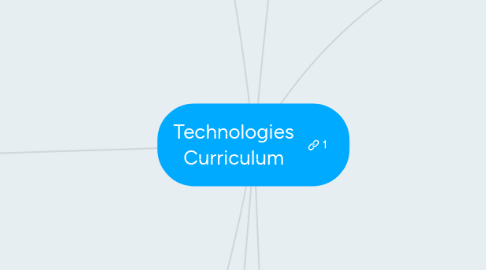
1. Achievement Standards: Band Levels
1.1. F - 2
1.1.1. Learn through purposeful and directed play.
1.1.2. Explore materials and technologies.
1.1.3. Use drawing and modelling to communicate design ideas.
1.1.4. Begin problem-solving: using digital systems, creating ideas/info, sharing.
1.2. 3 - 6
1.2.1. Offer explanations/demonstrations for sequence/organisation of ideas.
1.2.2. Begin recognising and appreciating other's ideas.
1.2.3. Respond resourcefully to a range of design/computing problems and situations.
1.2.4. Communicate and record ideas in diagrams/drawings using manual and digital technologies.
1.3. 7 - 10
1.3.1. Solve and produce creative solutions to problems/needs/opportunities.
1.3.2. Developed technologies practices: knowledge, understanding, processes, production skills, design, systems, computational thinking, organisation, project managing.
1.3.3. Communicate and record ideas using range of media and technologies.
2. Student Diversity
2.1. Students with disability
2.1.1. Use content from different levels (F - 10 sequence) or extended general capabilities.
2.2. English as an additional language/dialect
2.2.1. Allow extra time and support with explicit teaching that addresses language needs.
2.3. Gifted and talented students
2.3.1. Provision of enriching opportunities to cover learning area content in more depth/breadth.
2.3.2. Emphasis on specific aspects of general capabilities.
2.3.3. Focus on cross-curriculum priorities.
2.3.4. Utilise content from later band levels in curriculum.
3. General Capabilities
3.1. Literacy
3.1.1. Communicate ideas/concepts and recognise how language can be used to manipulate meaning. E.g. Read and interpret instructions/manual.
3.2. Numeracy
3.2.1. Calculate, measure, estimate to interpret and draw conclusions. E.g. Statistics and cost for making products or managing projects.
3.3. Information and communication technology
3.3.1. Develop and apply understanding of data, digital systems, audiences, procedures and computational thinking, as well as learn to operate specific software tools and digital hardware. E.g. Creating simulations, drawings and models.
3.4. Critical and creative thinking
3.4.1. Imagine, generate, develop, produce and critically evaluate ideas. E.g. Analysing and solve a problem through reasoning and abstract thinking, in designing process.
3.5. Personal and social capability
3.5.1. Cooperative/collaborative work in teams involving developed personal and social awareness, group decisions, conflict resolution, leadership roles. E.g. Project managing.
3.6. Ethical understanding
3.6.1. Understand and apply ethical and socially responsible principles when collaborating, creating and sharing. E.g. Investigating and working with data, materials, people and animals.
3.7. Intercultural understanding
3.7.1. Understand diverse use of technologies at different cultural levels and their impact on people's lives. E.g. Exploring ways people interact with technologies across cultural boundaries.
4. Cross-Curriculum Priorities
4.1. Aboriginal and Torres Strait Islander histories and cultures
4.2. Asia and Australia's engagement with Asia
4.3. Sustainability
5. Key ideas: Creating preferred futures
5.1. Thinking in technologies
5.1.1. Systems thinking
5.1.1.1. Aim: to provide methods for identifying and solving problems that affect the function of a whole system.
5.1.1.2. Process: analysis of system parts in order to recognise relationships between the parts and the system as a whole.
5.1.2. Design thinking
5.1.2.1. Aim: to develop strategies for understanding design needs/opportunities, and the planning, generating, evaluating of ideas.
5.1.2.2. Process: identify and investigate a need/opportunity to design a solution and process.
5.1.3. Computational thinking
5.1.3.1. Aim: to create solutions for digital technologies using integrated strategies.
5.1.3.2. Process: quantifying data to solve problems, and specifying and implemting algorithmic solutions to problems.
5.2. Project management
5.2.1. Aim: to ensure students are taught how to manage projects.
5.2.2. Process: planning, decision-making, collaborating and using resources for managing projects.
5.3. Animal ethics
5.3.1. Aim: to teach the care, use and interaction with animals.
5.3.2. Process: teaching activities that comply with the Australian Code of Practice for the care and use of animals for scientific purposes.
5.4. Information and communication technology
5.5. Safety
5.5.1. Aim: to identify and manage risks in technologies.
5.5.2. Process: implementation of projects that meet requirements of Work Health and Safety Act 2011.
6. Subjects
6.1. Design and Technologies (learning area)
6.1.1. Learning in this area
6.1.1.1. Projects: management, collaboration, teamwork, enterprise, marketing.
6.1.1.2. Curriculum implementation and integration of strands.
6.1.1.3. Design: processes, creative thinking.
6.1.1.4. Food and fibre production in Australia Curriculum: key processes of production, marketing, consumption, sustainable use of resources and waste recycling.
6.1.1.5. Food and nutrition in the Australian Curriculum: nutrition knowledge applied through design and preparing of food for specific purposes and users.
6.1.2. Knowledge and understanding (strand)
6.1.2.1. The use, development and impact of technologies in people's lives.
6.1.2.2. Design concepts across a range of technologies contexts.
6.1.3. Processes and production skills (strand)
6.1.3.1. Critiquing, exploring and investigating needs or opportunities.
6.1.3.2. Generating, developing and evaluating design ideas for designed solutions.
6.1.3.3. Planning, producing (making) and evaluation designed solutions.
6.2. Digital Technologies (learning area)
6.2.1. Knowledge and understanding (strand)
6.2.1.1. How data are represented and structured symbolically.
6.2.1.2. The components of digital systems: software, hardware and networks.
6.2.1.3. The use, development and impact of information systems in people's lives.
6.2.2. Processes and production skills (strand)
6.2.2.1. Collecting, managing and interpreting data when creating information, and the nature and properties of data, how it is collected and interpreted.
6.2.2.2. Using a range of digital systems and their components and peripherals.
6.2.2.3. Defining problems and specifying and implementing their solutions.
6.2.2.4. Creating and communicating information, especially online, and interacting safely using appropriate technical and social protocols.
6.2.3. Learning in this area
6.2.3.1. Online communication.
6.2.3.2. Solutions.
6.2.3.3. Strand content integration.
7. Aims
7.1. To develop student knowledge, understanding and skills in a range of technologies and ways.
7.1.1. Knowledge and understanding
7.1.1.1. Understand how technologies developed over time.
7.1.1.2. Informed perspective on technologies to engage confidently and make ethical and sustainable decisions (through critique and evaluation) about technologies.
7.1.2. Skills
7.1.2.1. Use of technologies: creative, innovative, enterprising.
7.1.2.2. Make effective and responsible decisions in choice and manipulation of technologies, resources, data, etc.
7.1.2.3. Ability to engage in technologies to find solutions: investigate, design, plan, manage, create, produce, evaluate.
